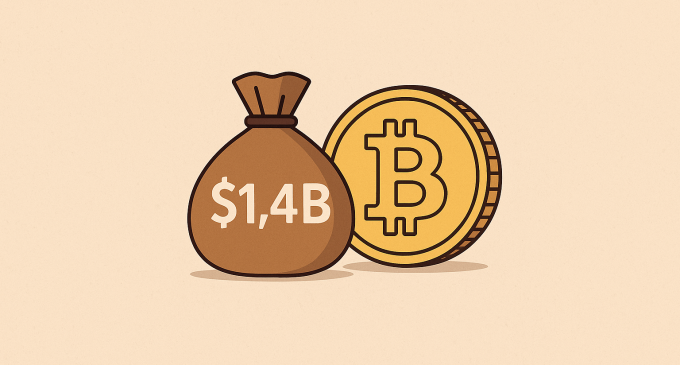
Introduction
The cryptocurrency market is once again under the global spotlight, but this time not because of price volatility or retail speculation. Instead, it’s the staggering accumulation of Bitcoin by the world’s largest asset manager, BlackRock, that has drawn attention. In a strategic move, BlackRock reportedly purchased $1.4 billion worth of Bitcoin over six consecutive trading days, reinforcing the narrative that institutional interest in digital assets is no longer speculative — it’s structural.
This monumental buying spree, occurring in mid-June 2025, comes amid a broader surge in spot Bitcoin exchange-traded fund (ETF) activity, driven by investor demand and shifting macroeconomic tides. As Bitcoin’s narrative transitions from digital gold to a mainstream investment asset, BlackRock’s aggressive positioning signals a deeper shift in the global financial landscape.
A Breakdown Of The $1.4 Billion Bitcoin Buying Streak
According to Crypto.news, BlackRock’s recent purchases were not a single-day market play but a sustained acquisition effort carried out over six days. The accumulation was spread through its flagship iShares Bitcoin Trust (IBIT), which has emerged as one of the top-performing spot Bitcoin ETFs since its approval earlier this year.
This spree marked the most aggressive buying streak by any single institutional player in Q2 2025, outpacing even rival institutions like Fidelity, Ark Invest, and Grayscale. While market watchers have speculated on BlackRock’s motivations, the strategic timing of this move aligns with several key developments in the crypto and broader financial markets.
Bitcoin ETFs Fuel A New Wave Of Institutional Demand
The ETF approval wave that swept the United States and other regions in late 2024 laid the groundwork for a transformation in crypto investing. Unlike previous cycles that relied heavily on retail investors and unregulated exchanges, the introduction of regulated Bitcoin ETFs has enabled traditional investors to gain exposure to BTC via familiar instruments.
BlackRock’s IBIT ETF is now among the most successful in terms of assets under management (AUM), surpassing $18 billion in holdings as of June 2025. Much of this growth has come from institutional portfolios reallocating traditional assets into crypto, signaling a broader acceptance of Bitcoin as part of a diversified investment strategy.
Notably, June 2025 marked the highest net inflows into U.S.-based Bitcoin ETFs since their approval, with BlackRock accounting for more than 35% of the total inflows during the month. This capital influx is not simply a reaction to price action; it is a reflection of how Bitcoin is increasingly seen as a hedge against macroeconomic uncertainty.
BlackRock’s Strategic Timing: What’s Behind The Move?
Several factors explain BlackRock’s calculated decision to increase its Bitcoin holdings in June 2025:
1. Macroeconomic Conditions and Interest Rate Pressures
The global economy is currently navigating a complex environment marked by high inflation, geopolitical instability, and central bank policy tightening. While the Federal Reserve has hinted at potential rate pauses, the uncertainty surrounding monetary policy has pushed institutional investors to seek non-correlated assets, like Bitcoin.
2. Improved Regulatory Clarity
The U.S. Securities and Exchange Commission (SEC) and Commodity Futures Trading Commission (CFTC) have issued clearer guidelines for digital assets in 2025, distinguishing Bitcoin and Ethereum from other altcoins and establishing a structured legal framework for ETF issuers. BlackRock, which has long lobbied for this clarity, likely saw the June environment as a green light for aggressive accumulation.
3. Market Sentiment and Momentum
After experiencing a sharp correction in May 2025, Bitcoin found support near the $60,000 mark and rebounded in mid-June. Institutional players like BlackRock are known to exploit these market dips for accumulation, often triggering price stabilization and positive momentum in the process.
Implications For The Crypto Market
BlackRock’s large-scale purchase has a ripple effect across the crypto ecosystem, reinforcing several critical trends:
Institutional Legitimacy
When a legacy financial giant like BlackRock makes a decisive move into Bitcoin, it lends validation to the asset class. Institutional investors, from pension funds to sovereign wealth funds, often look to leaders like BlackRock for signals. The $1.4 billion buy-in, therefore, is not just about Bitcoin; it is about setting a precedent for broader institutional adoption.
Reduced Volatility Through Liquidity
One of the major criticisms of Bitcoin has been its historical price volatility. However, with the growing participation of long-term institutional holders, the market is experiencing greater liquidity and reduced panic-driven swings. BlackRock’s presence introduces a stabilizing force that contributes to more predictable price movements, particularly around macro events.
ETFs as the Gateway for Mass Adoption
The success of Bitcoin ETFs is now widely seen as the most effective channel for bridging traditional finance (TradFi) and decentralized finance (DeFi). Retail and institutional investors can now access crypto through regulated platforms without worrying about private keys, wallet management, or exchange risks.
BlackRock’s Broader Crypto Strategy
BlackRock’s involvement in crypto isn’t limited to Bitcoin ETFs. Over the past two years, the firm has gradually expanded its footprint in the blockchain space:
Partnerships with Coinbase and Fidelity Digital Assets for custody and execution services.
Launch of tokenized assets and smart contract-based ETFs.
Venture investments in Web3 infrastructure startups.
Research initiatives in blockchain-based ESG investing models.
These efforts reflect a long-term strategic vision. While other institutions are cautiously testing the waters, BlackRock is actively building out an infrastructure that places digital assets at the core of its future offerings.
The Role Of Retail Investors And Broader Market Impact
While institutional flows are driving the current narrative, retail participation remains crucial. Interestingly, the announcement of BlackRock’s massive accumulation sparked renewed retail interest, particularly among investors who see such moves as bullish signals.
Crypto exchanges reported a 20–30% surge in new account registrations following the news, especially in North America and Europe. Social media platforms like X (formerly Twitter) and Reddit saw trending hashtags such as #BitcoinETF, #BlackRockBTC, and #CryptoBoom, further amplifying the buzz.
This convergence of institutional and retail energy could push Bitcoin toward another significant price discovery phase. However, the challenge remains to sustain this momentum without falling into another hype-driven cycle.
Bitcoin Price Performance Amid BlackRock’s Accumulation
From June 10 to June 18, the period during which BlackRock made its purchases, Bitcoin’s price rebounded from $61,200 to over $66,800, according to data from CoinMarketCap. While some of this growth can be attributed to market recovery, analysts suggest that large buy orders from BlackRock and similar players created strong upward pressure on price.
Moreover, on-chain data indicates a decline in exchange reserves and an increase in long-term wallet holdings — both strong indicators of bullish sentiment. As of June 19, Bitcoin is stabilizing around $65,500 with strong support and rising demand from both retail and institutional segments.
The Bigger Picture: Institutional Bitcoin Is Here To Stay
BlackRock’s Bitcoin play is not a one-off event. It is part of a broader institutional wave that includes players like:
Fidelity, which expanded its ETF and crypto IRA offerings.
Vanguard, which began exploring tokenized index products.
JP Morgan, launching a blockchain-based collateral network.
Goldman Sachs, developing Bitcoin derivatives for high-net-worth clients.
The entry of these firms changes the narrative, structure, and stability of the crypto market. The days of crypto being a fringe experiment are long gone. Today, it is becoming a pillar of modern finance, and institutions are taking a front seat in its development.
Conclusion
BlackRock’s $1.4 billion Bitcoin accumulation over six days is not just a number; it is a declaration. It reflects growing conviction in Bitcoin’s role as a financial asset, a hedge, and a long-term store of value. For investors, it validates crypto as an investable asset class. For regulators, it challenges outdated narratives. And for the crypto industry, it sets the stage for the next era of mainstream integration.
As the dust settles, one thing is clear: Bitcoin is no longer an outsider — it is becoming part of the financial mainstream. And institutions like BlackRock are leading the charge.







There are no comments at the moment, do you want to add one?
Write a comment